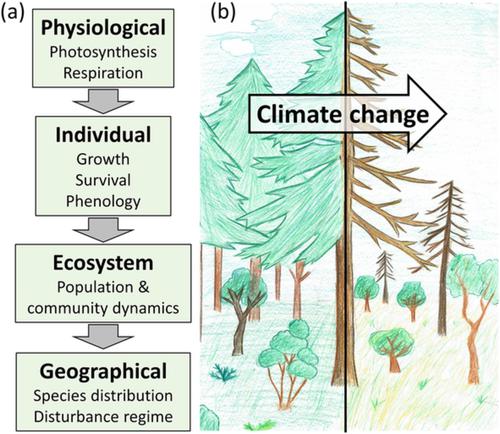当前位置:
X-MOL 学术
›
Ecol. Res.
›
论文详情
Our official English website, www.x-mol.net, welcomes your
feedback! (Note: you will need to create a separate account there.)
Predicting effects of climate change on productivity and persistence of forest trees
Ecological Research ( IF 1.7 ) Pub Date : 2020-05-18 , DOI: 10.1111/1440-1703.12127 Russell D. Kramer 1 , H. Roaki Ishii 2 , Kelsey R. Carter 3, 4 , Yuko Miyazaki 5 , Molly A. Cavaleri 3 , Masatake G. Araki 6 , Wakana A. Azuma 2 , Yuta Inoue 6 , Chinatsu Hara 2
Ecological Research ( IF 1.7 ) Pub Date : 2020-05-18 , DOI: 10.1111/1440-1703.12127 Russell D. Kramer 1 , H. Roaki Ishii 2 , Kelsey R. Carter 3, 4 , Yuko Miyazaki 5 , Molly A. Cavaleri 3 , Masatake G. Araki 6 , Wakana A. Azuma 2 , Yuta Inoue 6 , Chinatsu Hara 2
Affiliation

|
Global climate change increases uncertainty in sustained functioning of forest ecosystems. Forest canopies are a key link between terrestrial ecosystems, the atmosphere, and climate. Here, we introduce research presented at the 66th meeting of the Ecological Society of Japan in the symposium “Structure and function of forest canopies under climate change.” Old‐growth forest carbon stores are the largest and may be the most vulnerable to climate change as the balance between sequestration and emission could easily be tipped. Detailed structural analysis of individual large, old trees shows they are allocating wood to the trunk and crown in patterns that cannot be deduced from ground, thus can be used to more accurately quantify total forest carbon and sequestration. Slowly migrating species sensitive to novel climatic conditions will have to acclimate at the individual level. Accounting for physiological responses of trees to climate change will improve predictions of future species distributions and subsequent functioning of forest ecosystems. Field experiments manipulating temperature and precipitation show how trees compensate physiologically to mitigate for higher temperatures and drought. However, it is difficult to measure acclimation responses over long timeframes. Intraindividual trait variation is proposed as an indicator of acclimation potential of trees to future conditions and suggests that acclimation potential may vary among regional populations within a species. Integrating whole‐tree structural data with physiological data offers a promising avenue for understanding how trees will respond to climatic shifts.
中文翻译:

预测气候变化对林木生产力和持久性的影响
全球气候变化增加了森林生态系统持续运转的不确定性。林冠层是陆地生态系统,大气层和气候之间的关键纽带。在这里,我们将介绍在日本生态学会第66次会议上的“气候变化下森林冠层的结构和功能”专题讨论会上提出的研究。老龄森林的碳储量最大,可能最容易受到气候变化的影响,因为固存和排放之间的平衡很容易得到解决。对单个大的老树的详细结构分析表明,它们正在以无法从地面推断出的模式将木材分配给树干和树冠,因此可用于更准确地量化森林总碳和固存。对新的气候条件敏感的缓慢迁移的物种将不得不适应个人水平。考虑树木对气候变化的生理反应将改善对未来物种分布和森林生态系统后续功能的预测。操纵温度和降水的野外实验表明,树木如何进行生理补偿,以缓解高温和干旱。但是,很难测量长时间范围内的适应反应。提出了个体内性状变异作为树木对未来条件的适应潜力的指标,并表明适应潜力在物种内的区域种群之间可能会有所不同。
更新日期:2020-05-18
中文翻译:

预测气候变化对林木生产力和持久性的影响
全球气候变化增加了森林生态系统持续运转的不确定性。林冠层是陆地生态系统,大气层和气候之间的关键纽带。在这里,我们将介绍在日本生态学会第66次会议上的“气候变化下森林冠层的结构和功能”专题讨论会上提出的研究。老龄森林的碳储量最大,可能最容易受到气候变化的影响,因为固存和排放之间的平衡很容易得到解决。对单个大的老树的详细结构分析表明,它们正在以无法从地面推断出的模式将木材分配给树干和树冠,因此可用于更准确地量化森林总碳和固存。对新的气候条件敏感的缓慢迁移的物种将不得不适应个人水平。考虑树木对气候变化的生理反应将改善对未来物种分布和森林生态系统后续功能的预测。操纵温度和降水的野外实验表明,树木如何进行生理补偿,以缓解高温和干旱。但是,很难测量长时间范围内的适应反应。提出了个体内性状变异作为树木对未来条件的适应潜力的指标,并表明适应潜力在物种内的区域种群之间可能会有所不同。











































 京公网安备 11010802027423号
京公网安备 11010802027423号